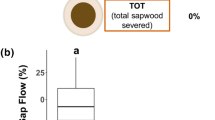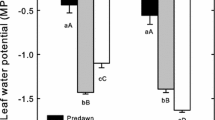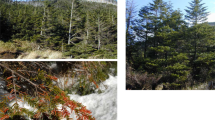Abstract
During the extreme 1992–1997 El Niño drought event, widespread stem mortality, or tree “dieback”, of both mature and juvenile eucalypts occurred within the tropical savannas of northeast Australia. Most of the dieback occurred in individuals of the ironbark species complex (Eucalyptus crebra – E. xanthoclada) while individuals of the bloodwood species Corymbia erythrophloia, exhibited significantly less stem mortality. Indicative of greater water stress, predawn and midday xylem water potentials of ironbark adults and saplings were significantly more negative than predawn values of bloodwoods. The very negative xylem water potentials in ironbarks suggest that stem mortality in both adult and juvenile ironbarks results from drought-induced embolism and that ironbarks perhaps have a shallower and less extensive root system than bloodwoods. Although predawn and midday water potentials for ironbark adults and saplings were similar, a census of mature and juvenile ironbark trees indicated that mortality was higher in adult trees. Cavitation vulnerability curves indicated that ironbark saplings may be better buffered against cavitation than adult trees. If they possess smaller root systems, saplings are more likely than adults to experience low xylem water potentials, even in non-drought years. Xylem conduits produced in adult trees during periods of normal rainfall, although perhaps more efficient in water conduction, may be more vulnerable to cavitation during infrequent severe droughts.




Similar content being viewed by others
References
Alder NN, Sperry JS, Pockman WT (1996) Root and stem xylem embolism, stomatal conductance, and leaf turgor in Acer grandidentatum populations along a soil moisture gradient. Oecologia 105:293–301
Auclair AND (1993) Extreme climatic fluctuations as a cause of forest dieback in the Pacific Rim. Water Air Soil Pollut 66:207–229
Burgess SOS, Adams MA, Turner NC, White DA, Ong CK (2001) Tree roots: conduits for deep recharge of soil water. Oecologia 126:158–165
Cochard H, Lemoine D, Dreyer E (1999) The effects of acclimation to sunlight on the xylem vulnerability to embolism in Fagus sylvatica L. Plant Cell Environ 22:101–108
Donovan LA, Linton, MJ, Richards JH (2001) Predawn plant water potential does not necessarily equilibrate with soil water potential under well-watered conditions. Oecologia 129:328–335
Enquist BJ, West GB, Charnov EL, Brown JH (1999) Allometric scaling of production and life-history variation in vascular plants. Nature 401:907–911
Fensham RJ, Holman JE (1999) Temporal and spatial patterns in drought-related tree dieback in Australia savanna. J Appl Ecol 36:1035–1050
Ford HA, Barrett GW, Saunders DA, Recher HF (2001) Why have birds in the woodlands of Southern Australia declined? Biol Conserv 97:71–88
Griffin JR (1973) Xylem sap tension in three woodland oaks of central California. Ecology 54:152–159
Hacke UG, Sperry JS, Pockman WT, Davis SD, McCulloh KA (2001) Trends in wood density and structure are linked to prevention of xylem implosion by negative pressure. Oecologia 126:457–461
Harvey HP, van den Driessche R (1997) Nutrition, xylem cavitation and drought resistance in hybrid poplar. Tree Physiol 17:647–654
Henderson RJF (1997) Queensland plants: names and distribution. Queensland Department of Environment, Brisbane, Australia
Kile GA (1981) An overview of eucalypt dieback in rural Australia. In: Old KM, Kile GA, Ohmart CP (eds) Eucalypt dieback in forest and woodlands. CSIRO, Melbourne, pp 13–26
Kirkpatrick JB, Marks F (1985) Observations on drought damage to some native plant species in eucalypt forests and woodlands near Hobart, Tasmania. Proc R Soc Tasmania 119:15–21
Landsberg J (1985) Drought and dieback of rural eucalypts. Aust J Ecol 10:87–90
Landsberg J, Wylie FR (1983) Water stress, leaf nutrients and defoliation: a model of dieback of rural eucalypts. Aust J Ecol 8:27–41
Lowman MD, Heatwole H (1992) Spatial and temporal variability in defoliation of Australian eucalypts. Ecology 73:129–142
Martin RAU, Burgman MA, Minchin PR (2001) Spatial analysis of eucalypt dieback at Coranderrk, Australia. Appl Veg Sci 4:257–266
Matzner SL, Rice KJ, Richards JH (2001) Intra-specific variation in xylem cavitation in interior live oak (Quercus wislizenii A. DC.). J Exp Bot 52:783–789
McFarlane C, Adams MA (1998) δ13C of wood in growth-rings indicates cambial activity of drought-stressed trees of Eucalyptus globulus. Funct Ecol 12:655–664
McIvor JG, Gardener CJ (1991) A description of the ECOSSAT experimental site at Cardigan near Charters Towers north Queensland. Trop Agron Tech Mem No. 68. CSIRO, Brisbane
McIvor JG, Gardener CJ (1995) Pasture management in semi-arid tropical woodlands: effects on herbage yields and botanical composition. Aust J Exp Agric 35:705–715
McIvor JG, Gardener CJ, Spain AV (1991) A description of the ECOSSAT experimental site at Hillgrove near Charters Towers north Queensland. Trop Agron Tech Mem No. 70. CSIRO, Brisbane
Mueller-Dombois D (1986) Perspectives for an etiology of stand-level dieback. Annu Rev Ecol Syst 17:221–243
Mueller-Dombois D (1990) Forest decline and soil nutritional problems in Pacific areas. Water Air Soil Pollut 54:195–207
Nepstad DC, Verissimo A, Alencar A, Nobre C, Lima E, Lefebvre P, Schlesinger P, Potter C, Moutinho P, Mendoza E, Cochrane M, Brooks V (1999) Large-scale impoverishment of Amazonian forests by logging and fire. Nature 398:505–508
Newell GR (1997) The abundance of ground-dwelling invertebrates in a Victorian forest affected by ‘dieback’ (Phytophthora cinnamomi) disease. Aust J Ecol 22:206–217
Newell GR (1998) Characterization of vegetation in an Australian open forest community affected by cinnamon fungus (Phytophthora cinnamomi): implications for faunal habitat quality. Plant Ecol 137:55–70
Old KM, Kile GA, Ohmart CP (1981) Eucalypt dieback in forest and woodlands. CSIRO, Melbourne
Old KM, Gibbs R, Craig I, Myers BJ, Yuan ZQ (1990) Effect of drought and defoliation on the susceptibility of eucalypts to cankers caused by Endothia gyrosa and Botryoshaeria ribis. Aust J Bot 38:571–581
Penfold AR (1961) The eucalypts: botany, cultivation, chemistry, and utilization. L. Hill, London
Podger FD (1981) Some difficulties in the diagnosis of drought as a cause of dieback. In: Old KM, Kile GA, Ohmart CP (eds) Eucalypt dieback in forest and woodlands. CSIRO, Melbourne, pp 167–173
Pook EW (1981) Drought and dieback of eucalypts in dry sclerophyll forests and woodlands of the southern tablelands, New South Wales. In: Old KM, Kile GA, Ohmart CP (eds) Eucalypt dieback in forest and woodlands. CSIRO, Melbourne, pp 179–189
Pook EW, Forrester RI (1984) Factors influencing dieback of drought-affected dry sclerophyll forest tree species. Aust J For Res 14:201–217
Pook EW, Costin AB, Moore CWE (1967) Water stress in native vegetation during the drought of 1965. Aust J Bot 14:257–267
Ritchie GA, Hinckley TM (1975) The pressure chamber as an instrument for ecological research. Adv Ecol Res 9:165–254
Richter H (1997) Water relations of plants in the field: some comments on the measurement of selected parameters. J Exp Bot 48:1–7
Salleo S, Hinckley TM, Kikuta SB, LoGullo MA, Weilbony P, Yoon TM, Richter H (1992) A method for introducing xylem emboli in situ: experiments with a field-grown tree: technical report. Plant Cell Environ 15:491–497
Sellin A (1999) Does pre-dawn water potential reflect conditions of equilibrium in plant and soil water status? Acta Oecol 20:51–59
Sparks JP, Black RA (1999) Regulation of water loss in populations of Populus trichocarpa: the role of stomatal control in preventing xylem cavitation. Tree Physiol 19:453–459
Sperry JS (1995) Limitations on stem water transport and their consequences. In: Gartner BL (ed) Plant stems: physiology and functional morphology. Academic Press, New York, pp 105–124
Sperry JS, Hacke UG (2002) Desert shrub water relations with respect to soil characteristics and plant functional type. Funct Ecol 16:367–378
Sperry JS, Saliendra NZ (1994) Intra- and inter-plant variation in xylem cavitation in Betula occidentalis. Plant Cell Environ 17:1233–1241
Tafangenyasha C (1997) Tree loss in the Gonarehzou National Park (Zimbabwe) between 1970 and 1983. J Environ Manage 49:355–366
Turner NC (1987) The use of the pressure chamber in studies of plant water status. In: Proceedings of the International Conference on Measurement of Soil and Plant Water Status, Logan, Utah. Utah State University Press, Logan, Utah, USA
Tyree MT, Sperry JS (1989) Vulnerability of xylem to cavitation and embolism. Annu Rev Plant Physiol Mol Biol 40:19–38
Tyree MT, Davis SD, Cochard H (1994) Biophysical perspective of xylem evolution: is there a tradeoff of hydraulic efficiency for vulnerability to dysfunction? IAWA Bull 15:335–360
Weste G, Brown K, Kennedy J, Walshe T (2002) Phytophthora cinnamomi infestation—a 24-year study of vegetation change in forests and woodlands of the Grampians, Western Victoria. Aust J Bot 50:247–274
Wylie FR, Bevege DI (1981) Eucalypt diebacks in Queensland. In: Old KM, Kile GA, Ohmart CP (eds) Eucalypt dieback in forest and woodlands. CSIRO, Melbourne, pp 31–36
Acknowledgements
We would like to thank Andrew Ash and Tony Grice for providing logistic support for this research. We also acknowledge the helpful comments of Jim Richards, Todd Dawson, and two anonymous reviewers. K.R. was supported in part by a Visiting Scientist grant from the Cooperative Research Centre for the Sustainable Development of Tropical Savannas.
Author information
Authors and Affiliations
Corresponding author
Rights and permissions
About this article
Cite this article
Rice, K.J., Matzner, S.L., Byer, W. et al. Patterns of tree dieback in Queensland, Australia: the importance of drought stress and the role of resistance to cavitation. Oecologia 139, 190–198 (2004). https://doi.org/10.1007/s00442-004-1503-9
Received:
Accepted:
Published:
Issue Date:
DOI: https://doi.org/10.1007/s00442-004-1503-9




